When it comes to owning a bearded dragon, understanding the difference between a male and female bearded dragon is more important than many new reptile owners realize. While both make fascinating, low-maintenance pets, the subtle distinctions between a male and female bearded dragon can influence everything from their behavior and size to their enclosure setup and long-term care needs.
Whether you’re trying to choose the right dragon for your home or simply want to identify the one you already have, this guide will walk you through everything you need to know. From physical traits and temperament to care tips and common myths, you’ll learn how to confidently tell the difference—and care for your bearded dragon like a pro.
Understanding Male and Female Bearded Dragon Differences
Telling the difference between a male and female bearded dragon isn’t always easy at first glance, but there are key traits that can help. From body shape to specific physical markers, understanding these signs is the first step to proper care and confident identification.
Key Physical Traits to Spot the Gender
One of the most reliable ways to tell if you have a male or female bearded dragon is by examining key physical features. Males usually have two distinct hemipenal bulges at the base of the tail, just below the vent (cloaca). Females, in contrast, tend to have a smoother underside with one small central bulge or none at all.
Another visible trait is the femoral pores, found in a row on the underside of the back legs. These pores are larger, more defined, and can become waxy or prominent in males—especially during mating season. In females, they’re usually small and barely noticeable.
Also, pay attention to size and shape. Male bearded dragons often grow slightly larger with broader heads and thicker tails. Females are generally smaller and have a more slender appearance overall. These traits are best observed when the dragon is calm and gently handled.
Behavioral Differences Between Male and Female Bearded Dragons
The behavior of a male and female bearded dragon can vary, particularly in social and territorial contexts. Males are usually more dominant and display assertive behaviors such as head bobbing, arm waving, and beard darkening. These displays are often signs of territorial defense or mating readiness.
Females, on the other hand, tend to be more passive—though not always. They may wave their arms as a sign of submission and are less likely to show frequent dominance behaviors. However, during breeding season, females can also become more active or agitated.
Males are typically more aggressive toward other males and may become stressed or combative if housed together. Females are more likely to coexist peacefully but can still exhibit dominance. Recognizing these patterns helps you anticipate mood changes and provide appropriate care, especially if you’re housing more than one dragon or planning introductions.
Behavioral differences may not appear until sexual maturity, but once they do, they become important cues in confirming gender.
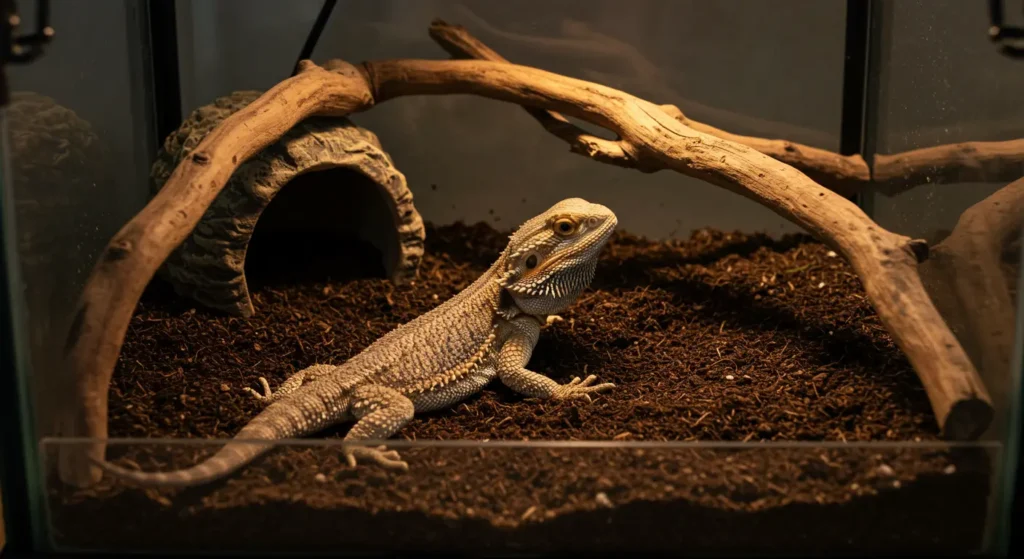
Can You Determine Bearded Dragon Gender at Any Age?
Determining the gender of a bearded dragon depends heavily on its age and stage of development. While some experienced keepers can guess the sex of a young dragon as early as 2–3 months, this is often unreliable. At this stage, their sexual characteristics haven’t fully developed.
By 4 to 6 months old, the gender traits of a male and female bearded dragon become more distinct. You can begin to spot subtle differences in body structure, femoral pores, and even tail thickness. The most accurate assessments typically occur after 8 months, when physical and behavioral signs are fully developed.
Juvenile dragons may still lack visible hemipenal bulges or pronounced pores, making gender identification difficult without proper lighting and technique. In some cases, a visit to a reptile vet for a more confident examination using a probing or ultrasound method may be needed.
Patience is key. Rushing to identify a dragon’s gender too early often leads to misidentification and poor enclosure planning, especially when housing more than one beardie.
Visual Guide: Male vs Female Bearded Dragon Anatomy
Visual comparisons are one of the most effective tools for identifying the gender of your bearded dragon. Using side-by-side images or diagrams of a male and female bearded dragon, you can clearly see differences in tail base shape, femoral pores, and head width.
For example, in a male dragon, the base of the tail—when gently lifted—reveals two bulges, one on each side. In females, the area appears flatter or shows a single central bulge. Photos can help new owners avoid common errors in judgment, especially when working with juveniles.
Visual guides should also include clear images of femoral pores and body posture, ideally taken during calm moments with the dragon under soft light. This allows you to compare subtle features like tail thickness and hip structure with confidence.
While photos are helpful, they are best used alongside hands-on inspection or professional confirmation. Still, a clear, well-labeled image set can dramatically improve your chances of identifying your dragon’s gender correctly at home.
Tailoring Care for Male and Female Bearded Dragons
While many care basics are the same, some subtle differences in behavior and physiology mean that a male and female bearded dragon may have slightly different needs. From habitat setup to daily interaction, tailoring your care approach can make a big impact. Let’s start by exploring whether males and females require different terrarium environments.
Do Males and Females Need Different Terrarium Setups?
Although the basic needs of both sexes are similar, subtle differences between a male and female bearded dragon can affect how you set up their enclosure. Both require proper heating, UVB lighting, and space to move, but males often benefit from slightly more room due to their territorial nature and larger size.
Males tend to be more active and may show dominance in smaller spaces, especially if another dragon is nearby. For this reason, it’s best to house males separately and provide visual barriers if they’re in the same room. A tank size of at least 75 gallons for males and 55–75 gallons for females is ideal.
Both genders need hiding spots and basking platforms, but females—especially those nearing egg-laying age—should also have a dig box filled with soft substrate like organic soil or sand. This gives them a safe place to lay infertile eggs, which some females do even without mating. Proper terrarium planning ensures your dragon stays stress-free and healthy.
Adjusting Temperament-Based Handling and Interaction
The temperament of a male and female bearded dragon can influence how you interact with them. Males are typically more dominant and display assertive behaviors, especially during mating season. You may notice head bobbing, black beards, and fast movements—signs that they might not want to be handled right away.
In contrast, females are generally calmer and more tolerant of frequent handling. However, during the egg-laying period, even the gentlest female may become defensive or restless. In these times, limit handling and allow her to stay in a quiet, comfortable space.
For both sexes, build trust through short, daily sessions. Start by gently hand-feeding or letting them rest on your arm. Always support their body fully and avoid grabbing them from above, which can trigger stress responses.
Learning your dragon’s personality helps you respond with patience and care. Whether you own a bold male or a relaxed female, adapting your approach will create a better bond and reduce stress for both of you.
Feeding Routines and Nutritional Considerations by Gender
Feeding routines for a male and female bearded dragon are mostly the same, but a few gender-specific considerations can improve overall care. Both require a balanced diet of insects, greens, and calcium-rich vegetables, but portion control and supplementation should be tailored to their activity levels and health needs.
Males, being slightly more active and larger, may require more protein during growth phases. However, overfeeding can lead to obesity, especially if the dragon is not regularly active. Monitoring portion size is essential.
Females need special attention during brumation and egg-laying cycles. Even without mating, many females produce infertile eggs. In such cases, increasing calcium intake and offering extra hydration becomes critical to prevent complications.
During breeding season or egg development, females may reduce their appetite or act unusually. Continue offering fresh greens and soft foods like squash or pumpkin to support them nutritionally. With careful observation, you can fine-tune your dragon’s diet to meet their unique gender-based needs.
Monitoring Health Risks Unique to Each Gender
While both sexes can suffer from common reptile illnesses, some health issues are more likely to affect either a male or female bearded dragon. Recognizing these risks early can help prevent serious complications.
In females, one of the most critical concerns is egg binding. This occurs when a female is unable to lay her eggs, which can become life-threatening without intervention. Signs include lethargy, bloating, digging behavior without laying, and loss of appetite. Providing a proper lay box and monitoring calcium intake are key preventive steps.
Males, on the other hand, may face aggression-related injuries, especially if housed near or with other males. They can also suffer from prolapsed hemipenes or stress from constant territorial displays. It’s important to give males space, visual privacy, and reduce triggers like reflections or competing reptiles.
Routine vet checkups and observation help catch these issues early. Tailoring your care based on gender will improve your dragon’s quality of life and longevity.
Can Male and Female Bearded Dragons Live Together?
Many new owners wonder if a male and female bearded dragon can safely share the same enclosure. While it may seem convenient—or even cute—housing them together comes with serious risks. Before making this decision, it’s important to understand the potential challenges and what experienced keepers recommend.
Housing a Male and Female Together: Risks vs Rewards
Housing a male and female bearded dragon in the same enclosure might seem like a good idea, but it comes with significant risks. While it’s true that some pairs may tolerate each other, especially outside the breeding season, the dangers usually outweigh the benefits.
Male dragons often display dominant behaviors, such as head bobbing, chasing, and mounting. These actions can lead to chronic stress or injury for the female, particularly if she’s not ready to mate. Prolonged exposure to stress can weaken her immune system and reduce her lifespan.
Even if mating occurs, it may result in unexpected egg-laying cycles, which put additional nutritional and physical strain on the female. There are very few actual “rewards” for housing them together unless you’re breeding them intentionally.
Most experienced reptile keepers recommend separate enclosures to ensure each dragon stays healthy, stress-free, and safe. If you’re considering cohabitation, it should be temporary, supervised, and only done with a full understanding of reptile behavior.
Breeding Concerns for New Owners
Breeding male and female bearded dragons requires planning, experience, and ongoing care. It’s not as simple as placing two dragons together and waiting for nature to take its course. In fact, it’s one of the most demanding aspects of reptile keeping.
Female dragons can lay up to 20–30 eggs per clutch, and some lay multiple clutches—even without a second mating. This puts extreme pressure on their calcium levels and body condition. Without proper supplements and a safe place to lay, females are at high risk of egg binding, a serious and sometimes fatal condition.
New owners are often unprepared for the extra care that hatchlings require. Baby dragons need specialized lighting, feeding schedules, and individual enclosures to thrive. Without this knowledge, survival rates drop significantly.
Unless you have prior experience or professional guidance, it’s best to avoid breeding altogether. Instead, focus on providing the best individual care possible for your bearded dragon.
Preventing Fights and Injuries in Shared Enclosures
Cohabitation between a male and female bearded dragon often leads to stress, fights, or injuries—especially if their behaviors go unnoticed. Males can become overly dominant, while females may respond with defensive postures, arm waving, or hiding.
Signs of stress include lack of appetite, frequent hiding, glass surfing, and darkened coloration. These may indicate the submissive dragon is feeling threatened or bullied. Physical injuries like tail nips, claw marks, or missing scales are clear warnings that separation is needed.
To prevent conflict, never house a pair together without a plan for immediate separation. Use visual barriers in multi-dragon rooms to reduce territorial displays. Keep separate basking zones, food dishes, and hiding areas if temporary cohabitation is unavoidable.
Monitoring your dragons daily is critical. If any aggressive behavior appears, it’s best to separate them permanently. Long-term cohabitation is discouraged by reptile vets and experienced keepers alike—individual enclosures promote healthier, safer dragons.
Expert Bearded Dragon Gender Identification Tips
Identifying whether you have a male or female bearded dragon can be tricky, especially for new owners. While physical traits offer clues, there are expert techniques and tools that can provide more accurate results. Let’s explore the best methods used by experienced keepers and reptile vets.
Using Femoral Pores and Hemipenal Bulges
Two of the most reliable physical traits for identifying a male or female bearded dragon are the femoral pores and hemipenal bulges. These features become more visible as your dragon matures, typically around 4–6 months of age.
Femoral pores are small openings located in a row on the underside of each back leg. In males, these pores are large, pronounced, and sometimes waxy—especially during breeding season. In females, they’re much smaller and less noticeable, often blending in with the surrounding scales.
Hemipenal bulges are located at the base of the tail, just beneath the cloaca. Males usually have two bulges—one on each side of the tail base—while females have either a single central bump or a flat underside in that area.
To view these features safely, gently lift the tail while your dragon is calm and under proper lighting. Never force or twist the tail, as this could cause stress or injury. With patience and careful observation, these markers can help you determine gender confidently at home.
When to Visit a Reptile Vet for Gender Confirmation
Sometimes, even experienced owners struggle to identify whether they have a male or female bearded dragon—especially when the dragon is young. In these cases, visiting a reptile-experienced veterinarian is the best option for accurate gender confirmation.
Vets can use a few methods to identify gender safely. The most common is probing, a technique where a sterile metal tool is gently inserted into the cloaca to determine the presence or absence of hemipenes. Another option is X-ray imaging, which can reveal reproductive organs or developing eggs in females.
For young dragons or situations where physical markers are unclear, ultrasound may also be used. These methods are quick, minimally invasive, and safe when performed by a trained professional.
If you’re planning to house multiple dragons or avoid accidental breeding, knowing the gender with certainty is essential. A vet exam ensures peace of mind and helps you make informed decisions about care and housing.
Common Myths About Male and Female Bearded Dragons
There are several persistent myths about the differences between a male and female bearded dragon, and believing them can lead to mistakes in care or housing. One common myth is that females are always gentler or more passive than males. While females may be calmer in some cases, temperament varies widely between individuals.
Another myth is that you can tell gender by color or pattern. In reality, both males and females come in a range of colors and morphs. Color is not a reliable gender indicator.
Some owners also assume that two bearded dragons of different sexes will get along better than two of the same sex. In truth, cohabitation is risky regardless of gender, especially when mating behavior or dominance is involved.
Lastly, many believe that females won’t lay eggs unless they’ve been bred. In fact, females can produce infertile eggs without ever mating, and this requires special care.
Understanding the facts helps new owners avoid these misconceptions and give their bearded dragons the care they truly need.
Final Tips for New Owners Raising a Male or Female Bearded Dragon
Whether you’ve just identified your dragon’s gender or are still unsure, proper care is key to their long-term health and happiness. These final tips will help you raise a thriving male or female bearded dragon, no matter your experience level.
Choosing the Right Gender Based on Your Lifestyle
When choosing between a male or female bearded dragon, it’s important to consider your lifestyle and experience level. Males are often more active, display territorial behaviors, and can be slightly more aggressive—especially during the breeding season. This means they may require more attention, patience, and handling boundaries.
Females, on average, are calmer and more tolerant of interaction. However, they come with their own challenges—particularly egg-laying, which can happen even without mating. This requires careful attention to calcium levels and potential health risks like egg binding.
For first-time owners, females may seem more manageable in terms of behavior, but only if you’re prepared for seasonal reproductive changes. Males might suit someone looking for a more expressive and interactive pet, but they need space and clear boundaries.
In the end, both genders can be rewarding companions. The key is understanding their tendencies and choosing the one that best fits your routine, confidence level, and long-term commitment.
Starter Checklist for Male and Female Bearded Dragon Owners
Every male and female bearded dragon needs a properly equipped habitat to thrive. Whether you’re setting up for a juvenile or an adult, your checklist should start with the right enclosure size—at least 75 gallons for males and 55–75 gallons for females.
Provide a basking area with a temperature of around 95–110°F and a cooler side near 75–85°F. Use high-quality UVB lighting that covers at least two-thirds of the tank and replace it every 6–12 months, depending on the brand.
Add essential elements like a hiding spot, climbing branch, and non-loose substrate such as tile or reptile carpet. Females may also need a lay box if they begin showing signs of egg-laying.
For nutrition, offer a mix of protein (like dubia roaches or crickets) and leafy greens. Supplement their diet with calcium and multivitamins—daily for juveniles and 2–3 times a week for adults.
This setup supports both male and female dragons and ensures they stay healthy and stress-free in their new environment.
Long-Term Care Habits That Promote a Healthy Beardie
Keeping your male or female bearded dragon healthy long-term comes down to consistent, proactive care. Start by observing your dragon daily for any changes in behavior, appetite, or energy levels. Sudden shifts can be early signs of illness or stress.
Ensure they stay hydrated by offering a shallow water dish, misting occasionally, or letting them soak in warm water baths a few times a week. Dehydration is a common issue in captive beardies and can lead to serious complications if ignored.
Enrichment is also vital. Allow your dragon out-of-tank time in a safe space, introduce climbing opportunities, and occasionally change the layout of their enclosure to keep them mentally stimulated. For females, watch closely for signs of egg-laying and provide extra calcium when needed.
Regular vet visits—ideally once a year—are helpful for both genders. With good lighting, a balanced diet, and attentive care, your bearded dragon can live a full, healthy life for 10 years or more.
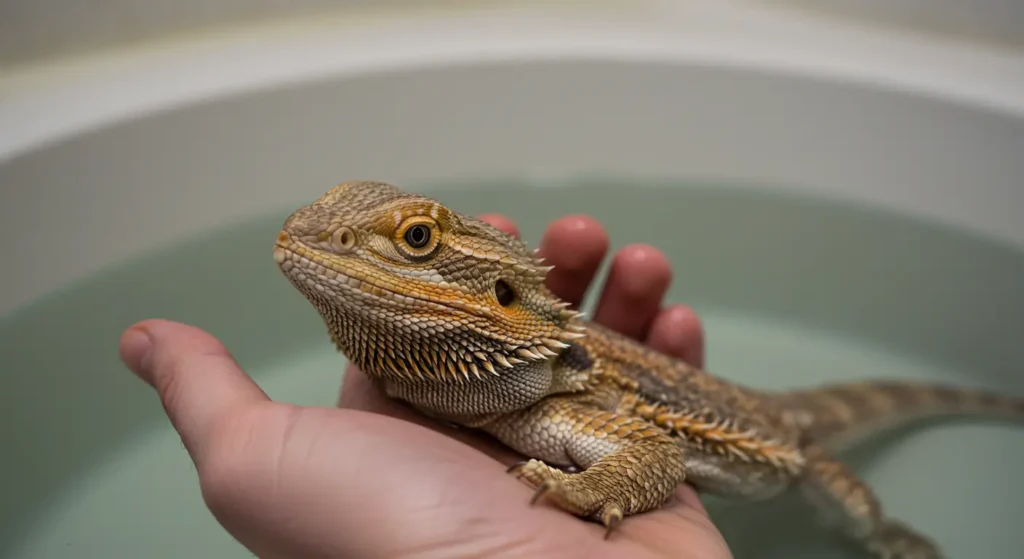
Frequently Asked Questions About Male and Female Bearded Dragons
How do you tell the difference between a male and female bearded dragon?
The easiest way to tell the difference is by looking at the base of the tail. Males have two hemipenal bulges and more pronounced femoral pores, while females usually have a single bump or a flat area and smaller pores.
Can a male and female bearded dragon share the same enclosure?
While it’s possible short-term, it’s generally not advised. Males can become dominant or aggressive, and females may become stressed or injured. Cohabitation also increases the chance of unwanted breeding.
Which is better for beginners: a male or female bearded dragon?
Both genders can be great pets, but they have different care needs. Males are more active and may display territorial behaviors, while females are calmer but can lay eggs, even without mating.
Do female bearded dragons need special care for egg-laying?
Yes. Female bearded dragons may lay infertile eggs, which requires extra calcium, hydration, and a proper lay box. Monitoring for signs of egg binding is also important.
At what age can you accurately determine the gender of a bearded dragon?
Most bearded dragons develop visible gender traits between 4 and 6 months of age. Before this, it’s often too early to tell without the help of a reptile vet.
Conclusion
Understanding the difference between a male and female bearded dragon is essential for providing the best possible care. From physical traits and behavior to housing needs and health risks, knowing your dragon’s gender helps you make smarter, more confident decisions as a reptile owner.
While both males and females make incredible pets, each comes with unique challenges and care considerations. Whether you’re a first-time keeper or planning to add a second beardie to your setup, always prioritize their well-being with proper habitat design, handling, and routine checkups.
With the right knowledge and preparation, you’ll be well on your way to raising a happy, healthy bearded dragon—no matter the gender.

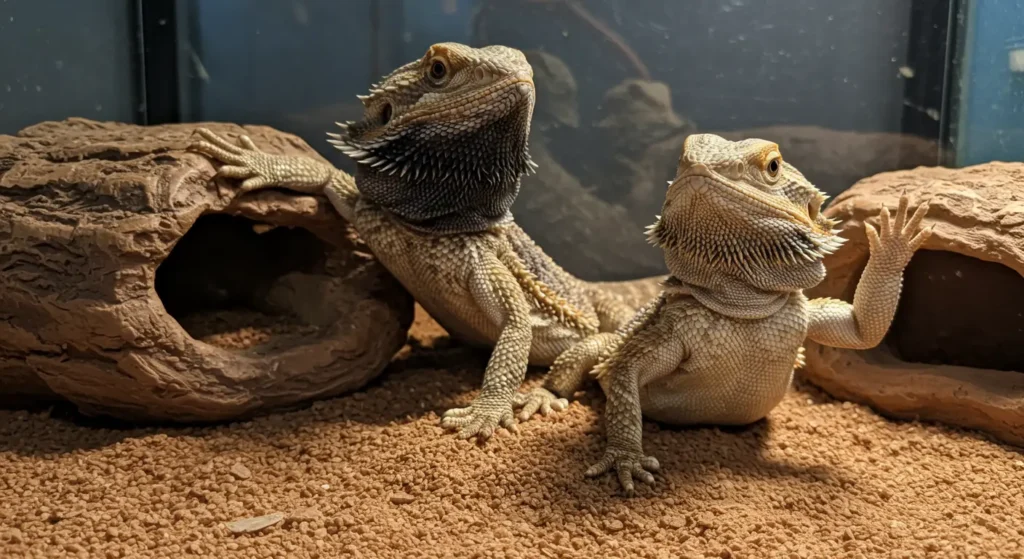


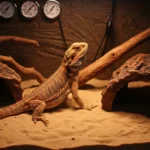

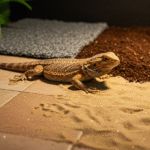
1 thought on “Male and Female Bearded Dragon Care Tips for New Owners”